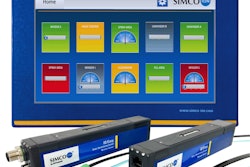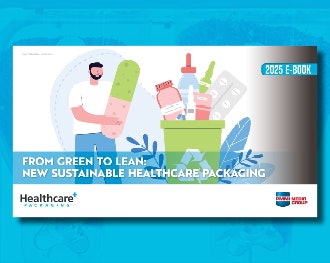
While Kenvue may not be a household name, its collection of iconic brands—among them Aveeno, Band-Aid, Johnson’s Baby, Listerine, Neutrogena, and Tylenol, to name just a few—touch the lives of more than 1.2 billion people across the world every day. Based on Kenvue’s 2024 financial reports, the company generated $15.5 billion in annual revenue and manages a portfolio of 40 global brands. As the world’s largest pure-play consumer health company by revenue, Kenvue is working to make those everyday interactions healthier for the planet as well.
Under its Healthy Lives Mission ESG strategy, deployed in 2023, Kenvue has established bold sustainability targets aimed at transforming its packaging portfolio. At that time, the company pledged that 100% of its packaging would be recyclable or refillable by 2025. It also committed to reducing its use of virgin plastic in packaging by 25% by 2025 and by 50% by 2030, using 2020 as its baseline year.
These goals align with Kenvue’s broader environmental commitments, which include a 42% reduction in Scope 1 and 2 greenhouse gas emissions by 2030. Since 2020, it has achieved a 26% reduction. The goals also align with the Ellen MacArthur Foundation (EMF)’s Global Commitment, of which Kenvue is a signatory. The Global Commitment is a worldwide initiative to create a circular economy for plastics. Signatories commit to ambitious targets to eliminate problematic plastics, increase recyclability, and incorporate more recycled content across their portfolios.
“Our journey toward circularity and environmental stewardship is deeply rooted in our core values, and we have always strived to make a positive impact on both people and the planet,” says Sushil Iyer, head of global packaging R&D at Kenvue. “When setting our sustainable packaging goals, we conducted a comprehensive analysis of our current practices, industry trends, and consumer expectations. This thorough evaluation helped us identify key areas where we could make the most significant and lasting impact.”
 | Read this related article, “Listerine Advances More Sustainable Oral Care Packaging” |
According to EMF’s 2024 Global Commitment Progress Report, based on signatories’ progress at fiscal year-end 2023, Kenvue had achieved a 21% reduction in virgin plastic use versus 2020 and reported that 71.4% of its plastic packaging was reusable, recyclable, or compostable. At this time, it has not yet reached its 2025 goals.
“The latest report is based on 2023 annual tonnage data,” says Iyer. “We’ve made strides on reducing virgin plastic across our portfolio and are shifting to more recycled content while continuing to unlock new paths through industry collaborations.”
Embedding circularity across brands and materials
Kenvue’s brand portfolio spans three main segments: Skin Health and Beauty, with products such as Clean & Clear, Lubriderm, and Rogaine; Essential Health, with products that include Desitin, Neosporin, and Stayfree; and Self Care, with Benadryl, Nicorette, and Zyrtec—among others. With product formats as varied as these, Kenvue’s packaging strategy encompasses a wide variety of materials and formats. Packaging types include bottles, jars, tubes, closures, pumps, and cartons. Packaging materials consist of PET, polyethylene, polypropylene, glass, and paper, all of which are recyclable in many of Kenvue’s markets today, says Iyer.
“Our focus is always on selecting the best packaging materials that deliver the desired brand equity, quality, and consumer experience,” he explains. “By doing so, we ensure that our packaging not only meets our high standards, but also aligns with our commitment to sustainability.”
To support its goals, Kenvue has embedded sustainable design into its global packaging development process. The company has developed comprehensive design guides and playbooks that all brand teams must follow. These include principles for Design for Recycling (DfR), which provides guidance on the appropriate use of PCR content, refillable and reusable formats, and recovery-friendly features.
Kenvue has also created the Sustainable Innovation Profiler, an internal tool that evaluates the environmental performance of new products—including both formulation and packaging—with the goal of ensuring that 75% of New Product Development (NPD) meets improved sustainability criteria. According to Iyer, it was designed with feedback from all the participants in a product’s life cycle. “It helps assess how new products can deliver against our Healthy Lives Mission by embedding the principles for adopting more sustainable ingredients and packaging materials into new innovations,” he explains.
In addition to internal tools, Kenvue leverages peer-reviewed LCA analysis from external partners and suppliers to support product environmental claims.
Innovations that reduce, replace, recover, and refill
Kenvue organizes its sustainable packaging innovations around four primary strategies: reduce, replace, refill/reuse, and recover, with some packaging innovations falling under several categories. The company has implemented changes across its brands and regions to remove unnecessary materials and transition to lower-impact alternatives.
Among some of the packaging innovations cited in the EMF Report:
Reduce/Replace: Le Petit Marseillais has optimized the bottle design for its shower gel to reduce overall plastic use, while incorporating 30% PCR. In India, Stayfree redesigned the size of its film bags to reduce the amount of plastic used. In the U.S. and Europe, Kenvue redesigned the bottle for its OGX hair care products to be lighter and contain 100% rHDPE (see sidebar below).
Replace: In Europe, Middle East & Africa (EMEA), Le Petit Marseillais lipstick containers eliminated polystyrene, moving to a mono-material plastic instead.
Replace/Recover: In Latin America (LATAM), Listerine transitioned its security seals to PET from PETG. PETG is not widely accepted in recycling systems, while PET is commonly recycled. In North America, Zyrtec redesigned its secondary packaging, moving from a blister pack to a plastic-free carton for recyclability (see sidebar on below). Also in LATAM, Listerine transitioned from using a black cap to a clear one that can be recycled. Aveeno lotion bottles now use 50% PCR, replacing virgin plastic, and are recyclable, excluding labels. The bottles also feature a pump that can be recycled in many markets (see sidebar below).
Refill/Reuse: In North America and EMEA, Johnson’s Baby rolled out a refill-at-home range. In North America, Neutrogena launched Gentle Foaming Cleanser powder concentrate with a reusable bottle and pump (see sidebar below).
Recover: In North America, Neutrogena HydroBoost Water Gel and Cream transitioned from a plastic to a glass jar. In EMEA, Listerine updated its packaging with washable adhesive labels and introduced clear caps, enhancing compatibility with local sorting infrastructure. In LATAM, the brand transitioned to clear PET caps, replacing black caps that could not be detected in standard recycling streams.
Explains Iyer, “Our diverse portfolio allows us to explore multiple avenues and tailor our approach to different product lines, ensuring that each solution is optimized for both environmental impact and consumer satisfaction.”
Navigating design challenges in consumer health
Designing sustainable packaging in the consumer healthcare space presents unique challenges. Regulatory and performance requirements limit material substitutions. Packaging must preserve product efficacy, ensure hygiene, and support safety and child-resistance where needed.
“Some of the design tensions we face are related to balancing material performance with market regulations and channel requirements,” says Iyer. “Our R&D organization collaborates closely with procurement, suppliers, and other teams to ensure that we bring purpose-fit, high-quality, sustainable packaging formats to our brands.
“We’re accelerating a circular design path and approach to focus on recycled, recyclable, and refillable packaging solutions.”
 | Read this related article, “Johnson’s Baby Refill Cartons Cut Plastic, Cost” |
However, even as it designs for recyclability, Kenvue recognizes that infrastructure is uneven. The company defines “recycle-ready” packaging as that which is compatible with recycling processes, even if collection or processing is not yet available locally. According to Iyer, by joining forces with industry consortiums, pushing the envelope for broadening recycling adoption, and designing for recyclability, Kenvue is helping future-proof packaging circularity. At the same time, it continues to work closely with NGOs and policymakers to define widely recycled materials and advocate for increasing recovery.
“Designing recyclable or recycle-ready packaging starts with us, as brand-owners and product innovators,” Iyer says. “We are continuing to redesign many of our packages to align with curbside recycling collection per local rules as well as to be compatible with recycling technology.”
Materials and models for the future
Kenvue is looking ahead to new materials, technologies, and business models that will drive further progress. While mechanical recycling remains central to Kenvue’s strategy, the company is also exploring advanced recycling. Also referred to as chemical or molecular recycling, advanced recycling comprises a group of technologies that break down hard-to-recycle plastics into their molecular building blocks, enabling the production of new, virgin-quality resin.
“Kenvue has a complementary strategy that includes mechanical and advanced chemically recycled [ACR] materials,” explains Iyer. “One is not a replacement for the other, but certain products will require virgin-equivalent product aesthetics, performance, and safety, which makes ACR a good candidate.”
This approach enables Kenvue to maintain performance and compliance while continuing to reduce dependence on virgin fossil-fuel plastics. The company is evaluating which applications are best suited for each recycling method.
Also a key area of interest are pulp- and fiber-based materials. These materials offer promise for reducing plastic use in secondary packaging and could eventually replace some rigid formats.
At the same time, Kenvue is investing in packaging that delivers enhanced consumer experiences. This includes formats optimized for e-commerce, with improved durability and tamper-evidence. It also includes dispensing systems that offer ease of use, hygiene, and reduced waste.
“It’s an incredibly exciting time to be in the field of consumer healthcare packaging,” says Iyer. “Consumer behaviors are changing, categories are converging, and new product experiences are being unlocked through reimagined packaging. Formats that offer superior dispensing experience, improved e-commerce integrity, and on-the-go choices will continue to advance as consumers look for new ways to take care of themselves, their loved ones, and their planet.” PW

























